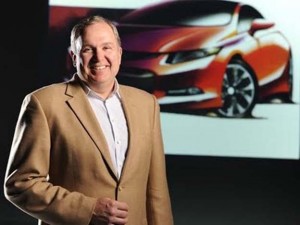As far as John Mendel is concerned New Year’s Eve can’t come soon enough. The top American executive at Honda says this has been the worst year the Asian automaker has experienced since it first entered the U.S. market – though with its factories now back up to full capacity Mendel believes Honda is finally back on track.
Honda has spent months struggling with shortages of most of its products — notably including the all-new Civic it launched earlier in the year, just before a devastating earthquake and tsunami struck Japan and seriously damaged that nation’s automotive infrastructure. Production is finally back up to normal, just in time for the upcoming launch of the redesigned 2012 Honda CR-V, long the dominant model in the compact crossover segment.
This year was “the worst I’ve seen,” said Mendel, during an interview while on the launch of the new CR-V. “We came out strong,” at the beginning of the year, with demand the strongest it had been since the U.S. economy collapsed in 2008, “and then, boom.”
Japan’s natural disaster has certainly had a severe impact; with many critical parts in short supply, Honda’s North American assembly plants lost about 200,000 units of production, noted Mendel. U.S. dealers were forced to dig dip into their inventories, which are down to barely 50,000 vehicles compared to 170,000 a year ago.
The good news is that by selling off whatever they had in stock they helped shore up Honda’s overall sales –which should be down only about 100,000 units for all of 2011 – and market share.
The challenge, now, will be to regain lost momentum. Some analysts believe it will be difficult for both Honda and Toyota – the bigger maker having been even harder hit by production shortages. Observers note that both brands have significantly ramped up incentives in recent weeks, hoping to lure back buyers who might be considering alternatives brand. But Mendel insisted that year-over-year Honda’s incentives aren’t up as much as it might seem.
Nonetheless, the maker clearly has a challenge ahead of it and is effectively starting over with the Civic launch campaign, while also getting ready to roll out the new CR-V before year-end.
The earthquake wasn’t the only problem for Honda in 2011. The new Civic received a mixed to negative response from reviewers – the influential Consumer Reports magazine bluntly criticizing the redesign. And even before the quake Honda was struggling to build momentum for some of the niche models in its line-up, such as the Insight and CR-Z hybrids.
For his part, Mendel downplayed those problems, noting that both cars were developed for a world audience and that they aren’t critical to the maker’s success in the States – a position some analysts find a bit self-serving.
The reality, notes Joe Phillippi, of AutoTrends Consulting, is that Honda has struggled with the launch of most recent non-core offerings, a situation worsened by the new Civic’s problems. So, it will be absolutely essential for the maker to score with the new CR-Z as well as the next-generation Accord, which Mendel confirmed will be coming to market in 2012.
Why Honda generally does so much better with core products like the Accord and CR-V may be explained by the fact that the maker’s U.S. operations has “a very strong voice” in their development, as opposed to a CR-Z or Honda Fit, both small cars primarily aimed at other markets. “They’re not designed for us,” he insisted.
It’s been three decades since Honda opened its first American assembly plant in Marysville, Ohio, and it has since established a network of plants all over North America. Significant upgrades and expansions are planned at many of those facilities, including the addition of a second shift at a factory in E, Liberty, Ohio and the addition of an all-new assembly line in Mexico.
The pace of the regional expansion is being driven not only by forecasted growth in sales and share but also by the need to continue reducing Honda of America’s dependence on the home market.
“It’s no secret anything coming from Japan is trending towards being much more expensive than it used to be,” what with the yen hovering below 80 to the dollar, said Mendel.
With the planned upgrades, Honda will be able to produce virtually all of its products, from the Fit subcompact to the midsize Ridgeline pickup, in North America.
And those plants will likely have more products to build in the years ahead. Among other things, the maker is expanding its electrification efforts. It has confirmed plans for a plug-in hybrid. And while it has not confirmed which model that will be based on, Mendel gave a winking nod when asked if it might be a version of the Accord, suggesting, “One could certainly draw that conclusion.”
Despite the financial hits Honda has taken this last year due to lost production, Mendel noted that the maker hasn’t cut back on its aggressive product development programs.
“We haven’t slowed the pace,” he stressed, “by one dime.”
There’s no question that Honda will face some challenges in the year ahead as Korean and domestic U.S. makers try to solidify gains they made while Honda was short of product. But there are other challenges facing the Japanese maker.
Honda is “still trying to evaluate” the impact of the ongoing flooding in Thailand that has hurt that country’s automotive infrastructure. This has already led Toyota to announce another cutback in its production. While Honda imports no products from Thailand to the U.S., Mendel said the company still isn’t sure if it may face shortages of parts and components supplied from Thailand. If that’s the case and it can’t find alternative sources Mendel will have even more reason to wish 2011 into the past.

